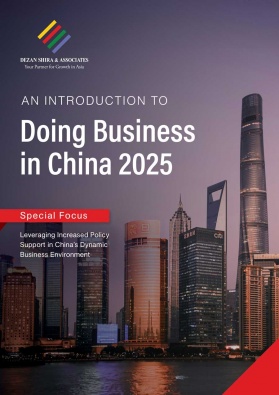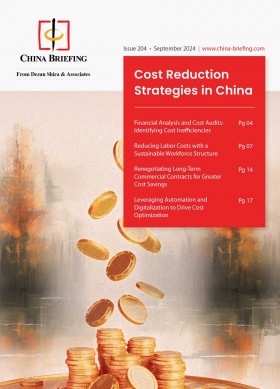China Proposes Price Advantage for ‘Made in China’ Products: Implications for Businesses and Investors
- China Ministry of Finance has proposed a 20 percent price advantage for “made in China” products in government procurement. This new draft policy is deemed as the government’s recent effort for boosting competitiveness of domestic industrial products and preventing foreign businesses from reshoring from China.
- Foreign-invested enterprises can benefit from clearer pathways to qualify as domestic producers, leading to deeper integration into China’s market. On the other hand, however, the new draft standards highlight the strategic importance of local manufacturing.
- However, the policy has raised concerns, especially from the EU, about potential protectionism and barriers to foreign suppliers, particularly in sectors like medical devices.
China’s evolving procurement policies signal a decisive move to support domestic manufacturing while providing opportunities for both local and foreign enterprises operating in China. Anchored in the broader goals of the Made in China 2025 (MIC 2025) strategy, these policies reflect the dual priorities of strengthening domestic demand and achieving technological self-reliance.
On December 5, 2024, the Ministry of Finance (MOF) released the Notice on Matters Related to Domestic Product Standards and Implementation Policies in the Field of Government Procurement–Draft for Comments (hereinafter, the “draft”, “draft policy”, or “draft standards”). The draft seeks to:
- Establish a clear definition for “domestic products” used in government procurement;
- Outline criteria and processes for determining eligibility for preferential policies; and
- Ensure transparency and fairness for all types of enterprises participating in government procurement, including state-owned, private, and foreign-invested businesses.
This policy initiative aligns with China’s strategic focus on modernizing its government procurement systems to reflect global best practices while advancing domestic economic goals.
The introduction of a 20 percent price deduction for products that meet domestic production standards in bid for public procurement highlights the government’s intention to bolster local supply chains while maintaining a level playing field for all enterprises. This policy shift, valued in the context of China’s expansive public procurement market worth over RMB 3 trillion (US$409.154 billion) annually, is expected to attract foreign businesses into localizing operations and investing in the country’s industrial ecosystem, and discouraging existing businesses from reshoring.
This article delves into the specifics of the new policies, evaluates their implications for different stakeholders, and offers practical strategies to navigate these changes effectively.
Key highlights of the new draft policy
New and clearer definition of domestic products
The draft policy clearly defines the criteria for recognizing “domestic products.” According to Article 1, Clause 1 of the draft, a product must meet three key requirements to qualify: (1) it must be manufactured within China; (2) the cost of domestically produced components must meet a specified threshold; and (3) it must comply with specific requirements for key components and critical manufacturing processes.
To be more specific, the following criteria must be met:
- Manufactured in China: The product must undergo a substantial transformation within China’s territory, changing its attributes from raw materials or components to a new product. Basic operations such as packaging, labelling, or simple finishing do not qualify as transformations.
- Domestic component costs: A significant proportion of the product’s components must be sourced and manufactured within China. The exact thresholds for this requirement will vary by industry and product category, with details to be determined through industry consultation.
- Key Components and processes: For certain products, additional requirements may mandate that key components be made in China or critical processes be carried out domestically.
Application scope
The draft policy specifies that the standards for domestic products apply exclusively to goods, including those procured for government procurement projects and service contracts that involve goods purchases. As a result, the policy does not extend to the procurement of standalone services. However, for infrastructure and construction projects, which constitute a significant portion of government procurement and typically involve both goods and services, the policy will apply to the goods procurement component.
It is important to note that “goods” do not include items such as land, buildings and structures, cultural relics and exhibits, books and archives, rare flora and fauna, agricultural and fishery products, minerals, electricity, municipal gas, steam and hot water, water supply, raw materials for food, beverages, and tobacco, as well as intangible assets. These categories are excluded due to their distinct production characteristics and market conditions, which require separate policy frameworks.
Support policies and domestic products
Article 3 of the draft policy stipulates that in government procurement activities where both domestically produced and non-domestically produced products compete, domestically produced products will receive a 20 percent price deduction. This means their quoted price will be assessed at 80 percent of the actual bid price during the evaluation process.
Meanwhile, for procurement projects or packages involving multiple products, if domestically produced products account for at least 80 percent of the supplier’s total product cost, the supplier’s entire offering will benefit from the 20 percent price deduction.
- Price deduction advantage: During procurement evaluations, domestic products will receive a 20 percent price deduction for comparison purposes.
- Broader application: If 80 percent or more of a supplier’s products in a bid meet domestic standards, all items in the bid will benefit from the price deduction.
The draft policy’s price deduction mechanism is expected to apply specifically to the pricing-related evaluation criteria within this assessment framework.
Equal treatment across enterprises
The policies ensure equal treatment for state-owned, private, and foreign-invested enterprises producing within China. Discrimination based on ownership type, investor nationality, or product branding is explicitly prohibited.
Implementation and verification
- Suppliers must provide declarations or supporting documents verifying compliance with domestic production standards.
- Procurement entities are required to accept these declarations without demanding additional evidence.
- False declarations will result in penalties under China’s Government Procurement Law.
Dispute resolution mechanisms
Clear guidelines are provided for resolving disputes over whether a product meets domestic manufacturing criteria. Suppliers may need to submit contracts, records, or other evidence to substantiate compliance with the rules.
Latest status of the draft policy
The draft policy is still in the legislative discussion stage, with the public consultation period having concluded on January 4, 2025. Following further revisions and deliberations, a final draft will be submitted for approval by the relevant authorities, after which it will gain legal validity.
How to understand the new ‘domestic product’ standards in government procurement?
A new regulatory framework for origin rules in government procurement
Currently, the standard for domestic products is determined by whether the final product requires import clearance procedures, a relatively straightforward but imprecise criterion. The classification of “domestic goods” involves legal, economic, political, and international trade considerations. Given the complexities of global supply chains, defining domestic products has become increasingly intricate. Additionally, in China, interdepartmental coordination presents further challenges, which is why explicit regulations on this matter have been lacking in existing laws and policies.
The MOF’s draft policy proposes specific standards and calculation formulas for determining domestic products, establishing a structured regulatory framework for origin rules in government procurement. It also reserves space for defining industry-specific domestic cost ratios over the next three to five years. Once formally implemented, this notification will create a new framework governing the origin standards in government procurement.
The MOF’s draft policy adopts an origin-based approach, emphasizing localizing key components and core manufacturing to retain high-value industries. By securing core technologies through domestic production, it aims to drive industrial upgrading, prevent technology outflows, and strengthen China’s manufacturing competitiveness.
Aligning with international practices
Since government procurement primarily relies on public funds from national taxpayers, it is widely accepted that such funds should be used in ways that benefit national economic and social development. Prioritizing domestic products in government procurement aligns with international practices. Many countries already implement similar policies. For example, government fleets such as South Korea and Japan primarily use domestically produced vehicles. In the United States, the government mandates that at least 50 percent of materials and products in procurement must be sourced domestically.
The draft policy of supporting domestic products in government procurement reflects China’s approach to utilizing public funds to prioritize national industries.
Compliance with WTO and the Foreign Investment Law
China did not join the World Trade Organization’s (WTO) Government Procurement Agreement (GPA) when it became a WTO member in December 2001. As a result, China’s government procurement market is not required to grant Most-Favored-Nation (MFN) treatment to other WTO member states. The MOF has explicitly stated in its explanatory notes that the draft provisions comply with WTO agreements, China’s WTO accession protocol, and other relevant international trade rules.
Furthermore, the draft policy applies equally to both foreign-invested and domestic enterprises. As long as foreign-invested enterprises produce goods that meet domestic product standards, they will be eligible for the same benefits under government procurement policies. Therefore, the draft does not violate China’s Foreign Investment Law.
Providing clear and unified standards for enterprises
Historically, China’s government procurement policies lacked a unified and transparent definition of domestic products, leading to inconsistencies in implementation. Procurement officials often faced challenges in distinguishing domestic products, as the criteria were ambiguous. Different procurement projects applied varying rules for products manufactured in bonded zones, domestically produced or registered foreign brands, and items that were only repackaged or rebranded in China.
The draft policy establishes a clear three-criteria framework for determining domestic products, helping businesses plan their supply chain and manufacturing strategies accordingly. By providing clear and predictable procurement standards, the draft is expected to enhance transparency in government procurement and offer businesses greater certainty in regulatory compliance.
What are the implications for businesses and investors?
The new policies present significant opportunities as well as challenges across the spectrum of domestic and foreign enterprises.
Growth catalyst and innovation pressure for Chinese companies
For Chinese companies, particularly small and medium-sized businesses (SMEs), the preferential treatment in government procurement can serve as a powerful catalyst for growth. However, it also places increased pressure on these firms to innovate and ensure their products meet stringent quality standards, given the competitive landscape. This dual demand for performance and compliance could drive advancements in technology and production efficiency but may pose challenges for less-prepared businesses.
FIEs to benefit from greater clarity and transparency but deeper localization required
Foreign invested enterprises (FIEs) benefit from the greater clarity and transparency offered by the new guidelines. The clear pathway to qualify as a domestic producer reduces uncertainties that previously hindered foreign participation in China’s procurement market. Nevertheless, meeting localization requirements, such as sourcing components and conducting key processes domestically, will require strategic adjustments. This could spur deeper partnerships with local suppliers and increased investment in domestic facilities, ultimately strengthening their integration into China’s economy.
How should businesses prepare for the draft policy?
Currently, two of the three criteria—(2) the proportion of domestic component costs and (3) requirements for key components and critical manufacturing processes—are expected to take three to five years to be fully refined. Until then, as long as a product is manufactured within China, it will be classified as a domestically produced product in government procurement activities. If the final policy maintains this language, government procurement in the initial years will primarily require that products be produced in China.
That said, foreign-invested enterprises should closely monitor legislative developments regarding criteria (2) and (3). For businesses with high reliance on imported components or critical manufacturing processes conducted overseas, it will be important to gradually enhance local production in response to policy changes. This includes increasing the share of domestically sourced components and shifting key manufacturing processes to China in an orderly manner.
Supply chain review, investing in innovation, and building proper documentation system
To align with China’s evolving policies in government procurement, businesses need to adapt proactively by refining their strategies and operations. A thorough review of supply chains is essential, ensuring that all components meet the defined domestic content thresholds. This requires evaluating whether raw materials, intermediate goods, and finished products are sourced and manufactured within China, as per the clarified requirements of the “domestic product” classification in the draft policy.
Investing in local R&D and production facilities is crucial for businesses aiming to adopt the “in China for China” strategy. Establishing these facilities not only enables companies to innovate within the framework of local demands but also aligns with broader governmental objectives of promoting indigenous innovation and achieving high localization rates in key industries such as medical devices.
Businesses must also focus on building robust documentation and compliance systems to streamline their participation in government procurement. With detailed rules for proving domestic content and the possibility of dynamic adjustments to ratio thresholds, having transparent and well-maintained records can mitigate risks of disqualification and enhance the efficiency of procurement processes.
Prepare for new opportunities
For investors, understanding the implications of government procurement trends is crucial in identifying growth opportunities. The domestic product standards present significant localization prospects, particularly in industries prioritised under the MIC 2025 initiative and the 14th Five-Year Plan. Medical devices, for example, are a focal sector, with targets to procure 70 percent domestically manufactured high-end devices by 2025.
Investors should actively monitor sectors where government support is robust, such as renewable energy, advanced manufacturing, and high-performance medical equipment. These industries are likely to see substantial growth due to policy-driven demand, creating opportunities for capital deployment in local companies or joint ventures with domestic firms.
Concerns among global trading partners
The draft released by China’s MOF underscores the government’s commitment to fostering a competitive, orderly, and market-oriented procurement environment. However, they also reflect broader industrial policy goals, such as promoting domestic innovation and reducing reliance on foreign imports.
Internationally, these policies have drawn scrutiny, particularly from the European Union. The EU has raised concerns over China’s practices favouring domestic procurement in sectors like medical devices, as highlighted in its investigation under the International Procurement Instrument (IPI). The EU’s findings suggest that China’s procurement policies, such as the “Buy China” initiative and requirements for high localization rates, disadvantage foreign suppliers and may violate principles of fair trade.
The EU’s report underscores specific concerns, such as the mandate that public hospitals procure a significant proportion of high-value medical devices from domestic suppliers. Additionally, stringent rules for approving imported products, including the application-evaluation-approval process and offset requirements, are viewed as barriers to market access for foreign firms.
Key takeaways
China’s domestic procurement standards are poised to reshape its market dynamics, offering opportunities for businesses and investors that can adapt effectively. While these policies aim to enhance local innovation and industrial self-reliance, they also raise questions about compatibility with international trade norms.
For businesses and investors, the evolving landscape presents both challenges and avenues for growth. Companies must navigate the complexities of compliance while leveraging opportunities in high-priority sectors. Policymakers, on the other hand, have the responsibility to ensure fair implementation, balancing national interests with global commitments.
The discourse around China’s procurement policies is likely to intensify as international stakeholders, particularly in the US and the EU, monitor their impact. While these standards offer clarity on domestic content requirements, their broader implications for global trade relations will depend on how they are enforced and perceived by international partners.
About Us
China Briefing is one of five regional Asia Briefing publications, supported by Dezan Shira & Associates. For a complimentary subscription to China Briefing’s content products, please click here.
Dezan Shira & Associates assists foreign investors into China and has done so since 1992 through offices in Beijing, Tianjin, Dalian, Qingdao, Shanghai, Hangzhou, Ningbo, Suzhou, Guangzhou, Haikou, Zhongshan, Shenzhen, and Hong Kong. We also have offices in Vietnam, Indonesia, Singapore, United States, Germany, Italy, India, and Dubai (UAE) and partner firms assisting foreign investors in The Philippines, Malaysia, Thailand, Bangladesh, and Australia. For assistance in China, please contact the firm at china@dezshira.com or visit our website at www.dezshira.com.
- Previous Article China Manufacturing Tracker: 2024-25
- Next Article Guide to Accounting and Audit in China 2025 – New Publication from China Briefing







